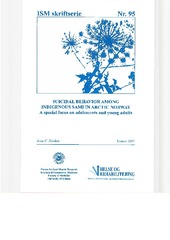Suicidal behavior among indigenous Sami in Arctic Norway : a special focus on adolescents and young adults
Permanent lenke
https://hdl.handle.net/10037/25934Dato
2007Type
Doctoral thesisDoktorgradsavhandling
Forfatter
Silviken, Anne C.Sammendrag
Since the 1950’s the global suicide rates have continued to increase, and today suicide has
become an important public-health problem worldwide (World Health Organization (WHO),
2002). According to WHO there are approximately one million deaths from suicide each year
worldwide, and about 20 times this number of people attempt suicide (2002). There are
substantial variations in the national suicide rates (Lester, 1997), and in addition great
variation in rates within the same country and between different ethnic groups (Roberts, Chen
& Roberts, 1997). During the last decades suicide rates have increased alarmingly among
indigenous people, and especially among indigenous residing in the Arctic, such as the lnuit
in Greenland (Leineweber et al., 2001) and in Canada (Sigurdson et al., 1994), and among
Alaskan Natives in the US (Borowsky et al., 1999). The increase in suicide rates among
indigenous people in the Arctic have been so alarmingly high that it has been described as an
epidemic level (Bjerregaard & Lynge, 2006; Leenaars, 2006) and it has been declared that
certain indigenous people have the highest suicide risk of any identifiable cultural (or ethnic)
group (Leenaars, 2006; Kirmayer, 1994). Unfortunately, suicide has become the leading cause
of death for young indigenous people, especially among males, and is a significant contributor
to potential years of life lost. Although there is carried out research on the prevalence of
suicidal behavior among several indigenous people, e.g. in Canada, Alaska, Greenland,
Sweden, Australia, New Zealand, our understanding of suicidal behavior among indigenous
people is still limited (Cutcliffe, 2005; Leenaars, 2006; Stewart, 2005).
There is no registration of ethnicity in the national population register in Norway, for that reason there are neither official statistics of health and living conditions nor suicide rates for indigenous Sami (hereafter called Sami). There have so far been conducted limited research on health and living conditions among Sami in Norway, and suicidal behavior has not previously been studied in a systematically way. Although some Sami communities have experienced high rates of suicides, there is in general lack of specific prevention strategies. Epidemiological knowledge about suicidal behavior among Sami is important for implementation of appropriate prevention strategies in Sami communities, and in addition useful to public health practitioners and policy makers in addressing this problem.
There is no registration of ethnicity in the national population register in Norway, for that reason there are neither official statistics of health and living conditions nor suicide rates for indigenous Sami (hereafter called Sami). There have so far been conducted limited research on health and living conditions among Sami in Norway, and suicidal behavior has not previously been studied in a systematically way. Although some Sami communities have experienced high rates of suicides, there is in general lack of specific prevention strategies. Epidemiological knowledge about suicidal behavior among Sami is important for implementation of appropriate prevention strategies in Sami communities, and in addition useful to public health practitioners and policy makers in addressing this problem.
Forlag
Universitetet i TromsøUniversity of Tromsø
Serie
ISM skriftserie Nr. 95, 2007ISM skriftserie Nr. 95, 2007
Metadata
Vis full innførselSamlinger
- ISM skriftserie [161]
Copyright 2007 The Author(s)


 English
English norsk
norsk